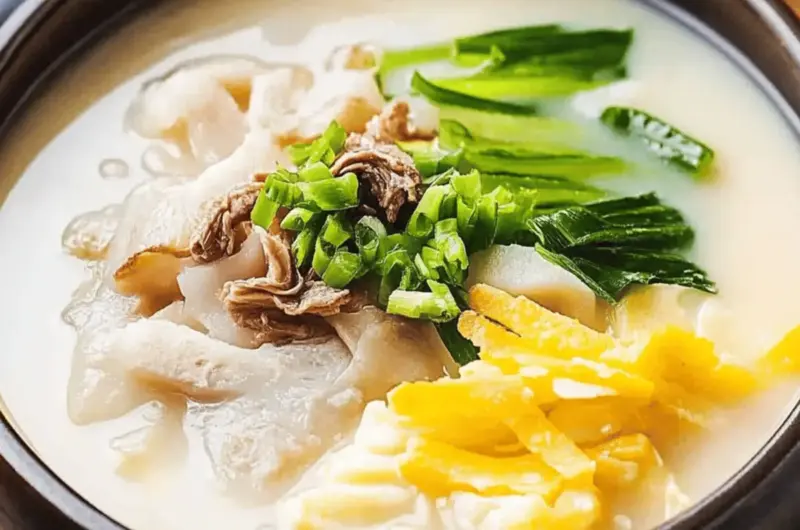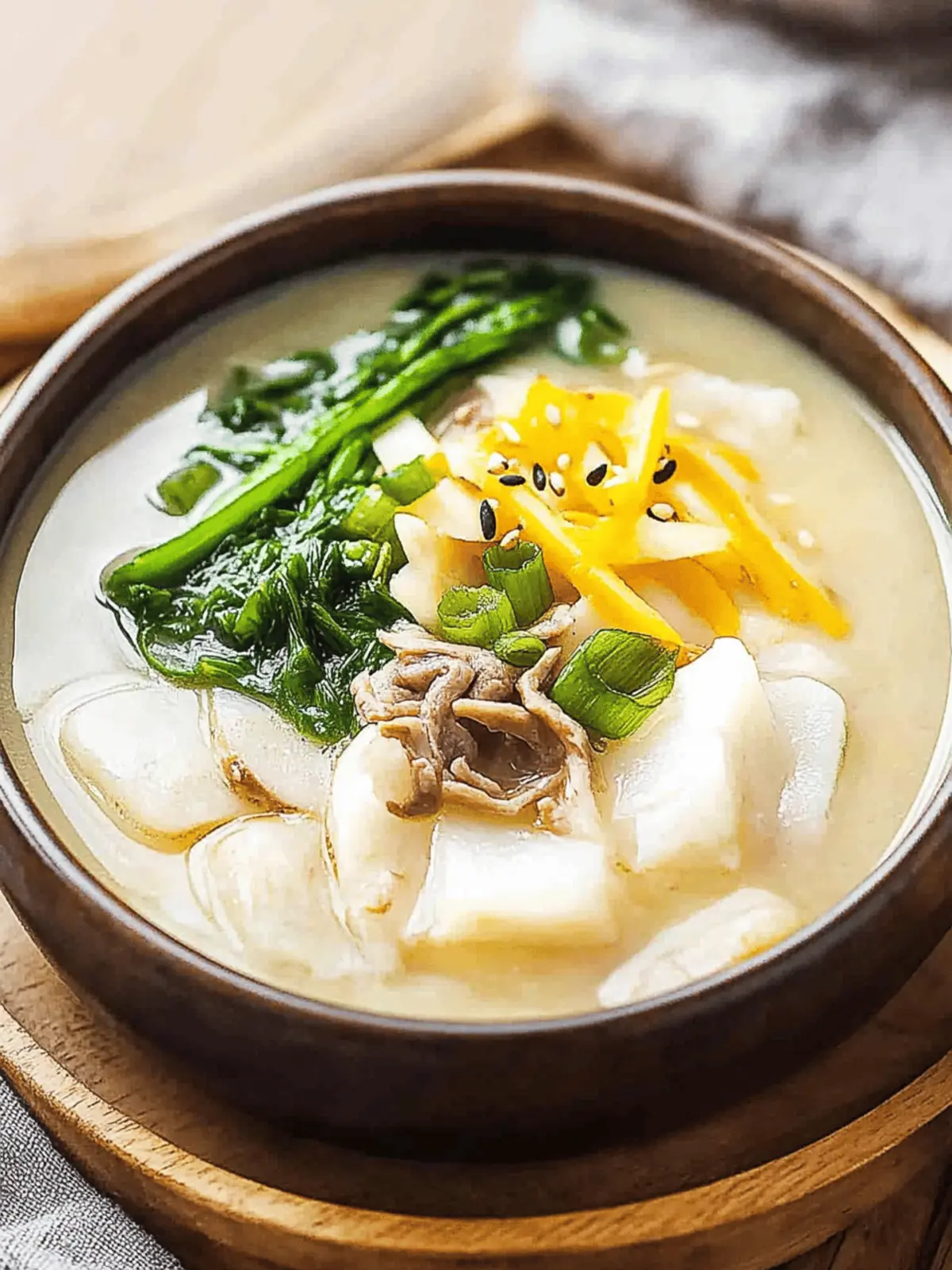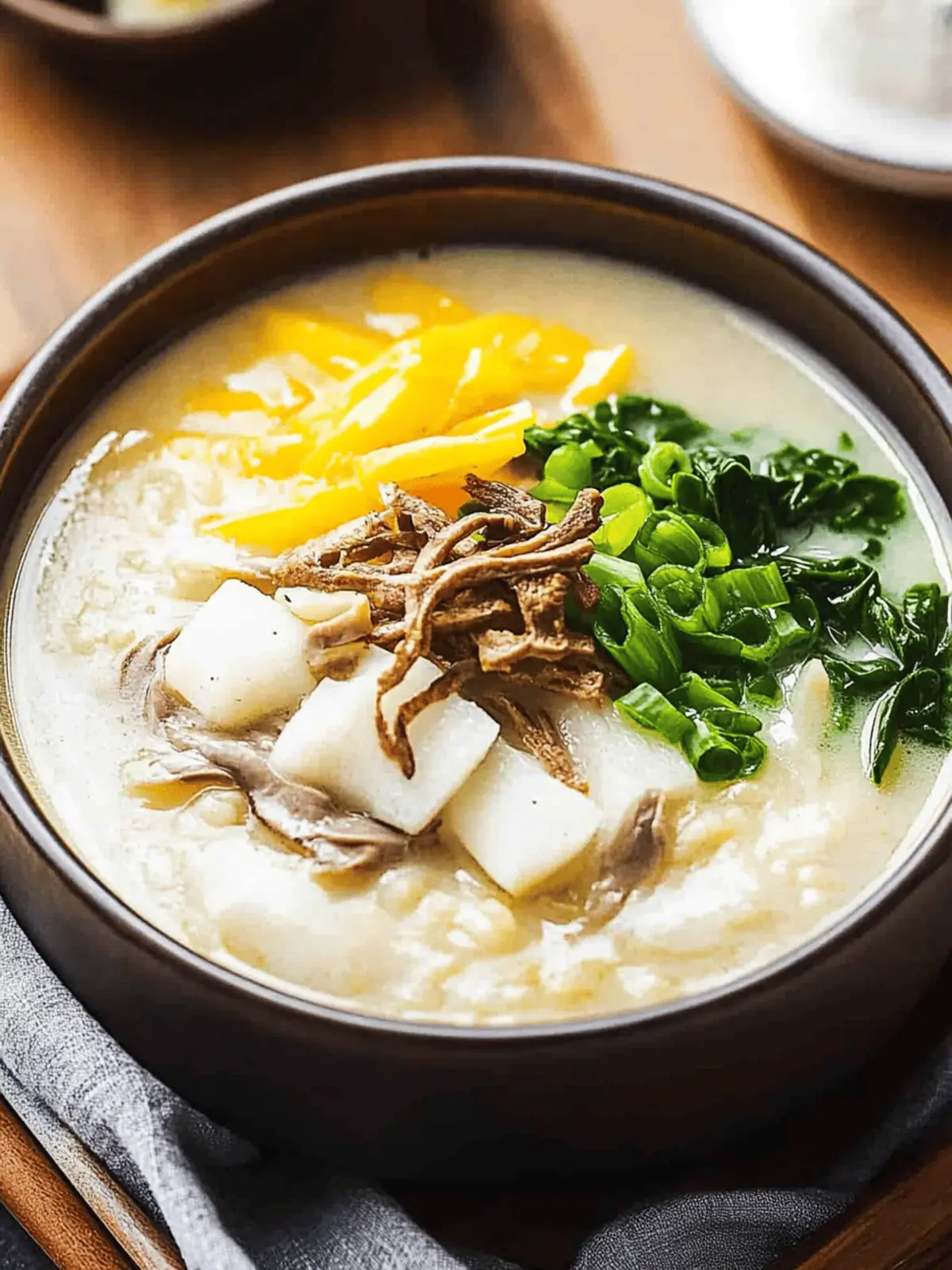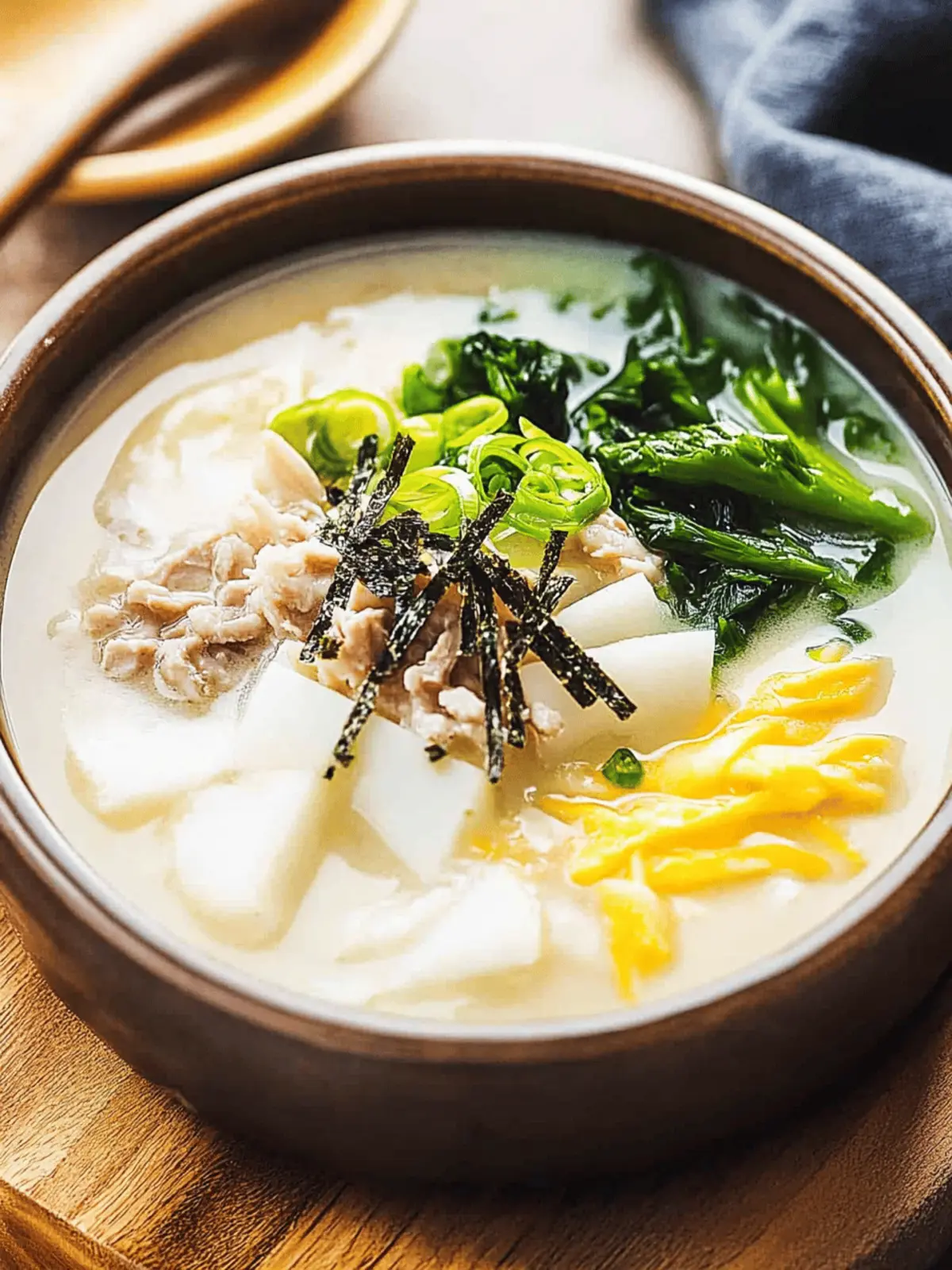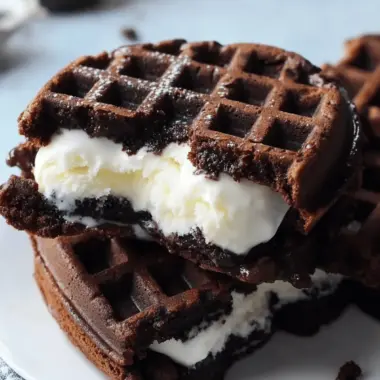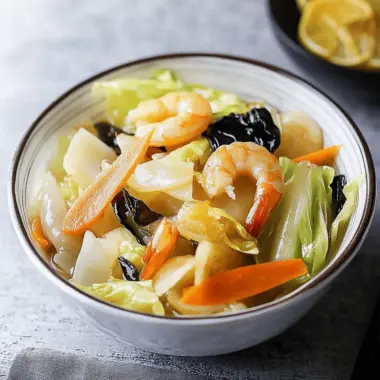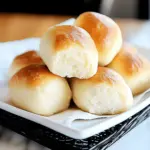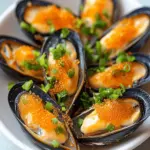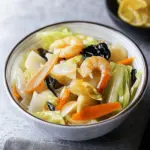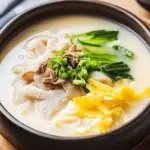The chill of winter always makes me crave something warm and nourishing, and nothing fits the bill quite like Korean Rice Cake Soup, or Tteok Mandu Guk. As the snow begins to blanket the ground outside, I remember huddling next to my grandmother as she stirred a bubbling pot of this comforting delight. The combination of chewy rice cakes, savory dumplings, and melt-in-your-mouth beef brisket creates a symphony of flavors that fills my kitchen with warmth and heart.
I often find myself looking for meals that not only satisfy my hunger but also bring a sense of joy and nostalgia. This soup does just that! With a hearty broth infused with the perfect balance of soy sauces, garlic, and a hint of sesame oil, even the simplest day transforms into a special occasion.
Whether you’re new to Korean cooking or a seasoned chef, this dish is surprisingly easy to prepare and makes for an impressive meal. So, grab your apron, and let’s dive into this cozy bowl of goodness that’s sure to become a favorite in your home!
Why is Korean Rice Cake Soup a must-try?
Comforting Warmth: The soothing broth enriched with beef brisket and spices brings an inviting warmth perfect for cold days.
Easy Preparation: With straightforward steps, you’ll have this delicious meal ready in under two hours, making it ideal for busy schedules.
Unique Ingredients: Featuring chewy rice cakes and Korean dumplings, this soup introduces delightful textures and flavors that stand out from regular soups.
Family-Friendly: Loved by all ages, Tteok Mandu Guk is a fantastic way to gather around the table and share a nourishing dish.
Versatile Dish: Customize it with your favorite toppings or proteins for a personalized touch. This Korean rice cake soup is sure to impress your family and friends!
Korean Rice Cake Soup Ingredients
Discover the essential components for your delightful Korean Rice Cake Soup.
For the Soup Base
• 1 lb Tteokguk Tteok – These Korean sliced rice cakes add a chewy, comforting texture to the soup.
• 1 lb beef brisket – This tender meat infuses rich flavors into the broth, making it truly savory.
• 9 cups cold water – The foundation for creating a light, yet flavorful broth.
• 1 medium onion – Left whole, it imparts a sweet aroma and depth to the broth as it simmers.
For Seasoning
• 1/2 tsp Guk Ganjang – This soup soy sauce adds umami richness that’s essential for the perfect broth.
• 1 tsp Jin Ganjang – A bit of regular soy sauce enhances the overall flavor profile.
• 1/2 tsp sea salt – Balances the flavors and brightens the soup.
• 2 tsp garlic (chopped) – Adds a delightful aromatic quality to the dish.
• 1-2 tsp sesame oil – A drizzle for a nutty finish that elevates the overall flavor.
• 1/2 tsp sugar – Helps to balance the savory notes and add a touch of sweetness.
• 1/8 tsp red chili pepper powder – For a whisper of heat, perfect for your taste!
• 1/8 tsp black pepper – For a subtle kick enhancing the flavor of the soup.
For the Dumpling Touch
• 8 each frozen Korean dumplings (mandu) – These tiny treasures add texture and are satisfying bites within the soup.
For Garnish
• 2 eggs (slightly whipped) – Swirling these into the hot soup offers a lovely richness and creaminess.
• 4 Tbsp green onion (chopped) – Finely chopped for fresh flavor and colorful presentation.
• 1/3 sheet dried sea laver (cut into strips) – Adds a touch of oceanic umami and a crispy texture to each bowl.
Optional Enhancements
• 2 green onions (optional) – Use these for an extra layer of fresh flavor if desired.
• Black pepper – Use to taste, adding a finishing touch to create personal perfection.
Gather these ingredients to whip up your very own bowl of Korean Rice Cake Soup that’s bound to warm both hearts and bellies!
How to Make Korean Rice Cake Soup
-
Soak the Tteok: If using frozen tteok, soak them in cold water for a couple of minutes until they fall apart. Drain them once separated to ensure a perfect texture in your soup.
-
Prepare the Onion and Beef: Peel the onion and leave it whole. Wash the green onions. If you’d like, soak the beef in cold water for about 30 minutes; this helps it bleed out and improves flavor.
-
Simmer the Broth: Combine water, beef, and onion in a pot. Bring to a boil over medium-high heat, uncovered. Once it’s boiling, lower the heat, cover, and let it simmer for 1 hour. Don’t forget to skim off any foam that forms!
-
Check Beef Tenderness: Test the doneness of the beef with a fork. If it’s tender, remove the brisket, let it cool, and cut into 1 1/2 to 2-inch pieces against the grain. Tear those pieces into smaller bits following the grain to keep them juicy.
-
Season the Beef: Season the torn beef pieces with the remaining soy sauces, garlic, green onion, and other garnish ingredients. Massage well to ensure the flavors meld beautifully.
-
Whisk Eggs: In a bowl, whisk the two eggs with a pinch of salt and set them aside for a creamy swirl later.
-
Enhance the Broth: Discard the onion from the broth. Season the beef broth by adding Guk Ganjang and sea salt to elevate those flavors.
-
Cook the Tteok and Dumplings: Add the tteok to the boiling broth and cover. Bring it back to a boil, then add the dumplings and simmer for about 5 minutes or until everything is fully cooked and floating.
-
Add the Eggs and Green Onions: When the rice cakes and dumplings are floating, swirl in the egg mixture. Add sliced or chopped green onions, then turn off the heat.
-
Serve: Ladle the soup into bowls and top each with the seasoned beef, chopped green onions, strips of sea laver, and a dash of black pepper for an extra touch of flavor.
Optional: Garnish with additional green onions for a fresh finish!
Exact quantities are listed in the recipe card below.
Korean Rice Cake Soup Variations
Feel free to explore your culinary creativity and make this comforting soup personal!
-
Vegetarian: Substitute beef with mushrooms like shiitake or portobello for a delightful umami kick. This twist still brings depth to the broth while staying plant-based.
-
Spicy Kick: Add sliced fresh chilies or a teaspoon of gochujang (Korean chili paste) for a bold heat that warms you from the inside out. The extra spice can elevate the overall flavor profile beautifully!
-
Dumpling Variety: Use shrimp or veggie dumplings in place of mandu for a refreshing change. Each option brings its unique taste and texture, making every bowl a surprise.
-
Warming Ginger: Incorporate fresh ginger slices while simmering the broth for a zesty warmth. Ginger not only enhances the flavor but also adds a comforting twist perfect for chilly days.
-
Creamy Addition: Stir in a splash of coconut milk or cream for a rich and creamy consistency. This change introduces an inviting sweetness that pairs well with the savory elements of the soup.
-
Noodle Delight: Throw in some udon or soba noodles for an even heartier meal. The noodles soak up the delicious broth and provide an extra layer of satisfaction.
-
Herb Infusion: Sprinkle in fresh herbs like cilantro or parsley just before serving for a burst of freshness. Each herb brings its unique aroma, enlivening the comfort of the soup.
-
Seafood Twist: Add fish cake or mussels for a delightful seafood flavor. This variation provides an interesting texture and makes the dish even more special.
Experimenting with these variations can create delightful surprises, ensuring your homemade Korean Rice Cake Soup stays exciting and enjoyable with each bowl you share!
How to Store and Freeze Korean Rice Cake Soup
Fridge: Consume leftovers within up to 3 days. Store in an airtight container to maintain freshness and flavor.
Freezer: Freeze the soup for up to 3 months. Place it in freezer-safe bags, removing as much air as possible to prevent freezer burn.
Reheating: Thaw overnight in the refrigerator. Reheat on the stove over medium heat until warmed through, adding a splash of water or broth if needed to restore consistency.
By following these storage tips, you can savor the delightful flavors of your Korean rice cake soup even longer!
Make Ahead Options
These delightful Korean Rice Cake Soup components are perfect for busy home cooks looking to save time! You can prep the beef (seasoned and cut), chopped green onions, and whisked eggs up to 24 hours in advance. Simply store the seasoned beef in an airtight container in the refrigerator to maintain its flavor and texture. The broth can be made and cooled, then refrigerated for up to 3 days. When ready to serve, reheat the broth and simply add the prepped rice cakes and dumplings, letting them cook for about 5 minutes. Finally, swirl in the egg mixture and garnish for a comforting meal that’s just as delicious and quick to finish!
What to Serve with Korean Rice Cake Soup?
Imagine gathering around the table with loved ones, sharing laughter and warmth, as you savor the comforting essence of this heartwarming dish.
-
Steamed Vegetables: Fresh, lightly salted broccoli or carrots bring a vibrant crunch that complements the richness of the soup. Their bright colors and nutritional value uplift the overall meal.
-
Korean Pickled Radish: The sweet and tangy bite of this traditional banchan balances the savory flavors of the soup. Each crunchy piece offers a refreshing contrast, making every spoonful feel special.
-
Savory Korean Pancakes: Crispy and filled with green onions, these pancakes provide a delightful texture alongside the soup. Dip them into soy sauce for an explosion of flavor that enhances the meal.
-
White Rice: A simple bowl of fluffy white rice is the perfect canvas for the broth and dumplings. It soaks up the flavors beautifully, making every mouthful a comfort-filled experience.
-
Hot Pepper Paste (gochujang): A spoonful of gochujang adds a delicious kick and depth of flavor. Mix it in for those who enjoy a spicy twist, ensuring your meal stays interesting.
-
Ginger Tea: Serve this healthy beverage alongside to cleanse the palate and warm up your spirited conversation. Its gentle spice beautifully complements the meal’s overall flavors.
-
Fruit Salad: A sweet, refreshing medley of pineapple, melon, and berries cleanses the palate and offers a light, juicy contrast to the savory soup. It’s a delightful way to finish the meal.
Pairing these tantalizing sides with Korean rice cake soup elevates a simple dish into a meal that’s not only satisfying but also a joyous occasion to share with others.
Expert Tips for Korean Rice Cake Soup
-
Soak Tteok Properly: Ensure frozen rice cakes are thoroughly soaked until they fall apart. This prevents them from becoming chewy instead of tender in the soup.
-
Flavor the Broth: Don’t skimp on seasoning! Adding enough Guk Ganjang and salt will enhance the depth of your Korean rice cake soup significantly.
-
Tender Beef Trick: Make sure to simmer the beef until it’s fork-tender. When cutting it, always slice against the grain for a more enjoyable texture.
-
Egg Swirl Sensation: Whisk the eggs just until combined before swirling them into the soup, resulting in beautiful ribbons that enrich the experience.
-
Presentation Matters: Garnish with fresh green onions and sea laver right before serving to add both flavor and a lovely visual appeal to your bowl.
-
Customize to Taste: Feel free to adjust the spice level by adding more chili pepper powder or even some vegetables to make the dish your own.
Tteok Mandu Guk Recipe FAQs
What type of Tteok should I use for this soup?
Absolutely! You’ll want Tteokguk Tteok, which are the Korean sliced rice cakes that provide that unique chewy texture. If you’re in a crunch or can’t find them fresh, frozen ones will do the trick! Just remember to soak them until they separate before adding them to your soup for the best results.
How do I store leftovers?
Very! Store your leftover Korean Rice Cake Soup in an airtight container in the fridge. Make sure to consume it within up to 3 days to best enjoy its flavors. If you want to keep it longer, consider freezing it.
Can I freeze Tteok Mandu Guk?
You sure can! Freeze the soup in portions for convenience. Use freezer-safe bags, and make sure to remove as much air as possible to avoid freezer burn. It should keep well for up to 3 months.
What if the beef isn’t tender enough after cooking?
No worries! If the beef isn’t fork-tender after the suggested simmering time, simply cover and continue to cook on low heat until it reaches that perfect tenderness. You could also slice the beef into smaller pieces or return it to the pot for a few minutes to speed up the process.
Is this soup safe for those with food allergies?
Always worth checking! This recipe includes soy sauce, which contains wheat and soy—common allergens. If you’re cooking for someone with allergies, consider using gluten-free soy sauce and check the dumpling ingredients. As for pets, avoid giving them any soup, especially with the seasonings included!
How should I reheat the soup after freezing?
Here’s a simple step-by-step! First, thaw your soup in the refrigerator overnight. When you’re ready to serve it, pour the soup into a pot and reheat over medium heat. If it seems thick, just add a splash of water or broth to get that perfect consistency again. Enjoy it warm, and it’ll taste almost as fresh as when you made it!
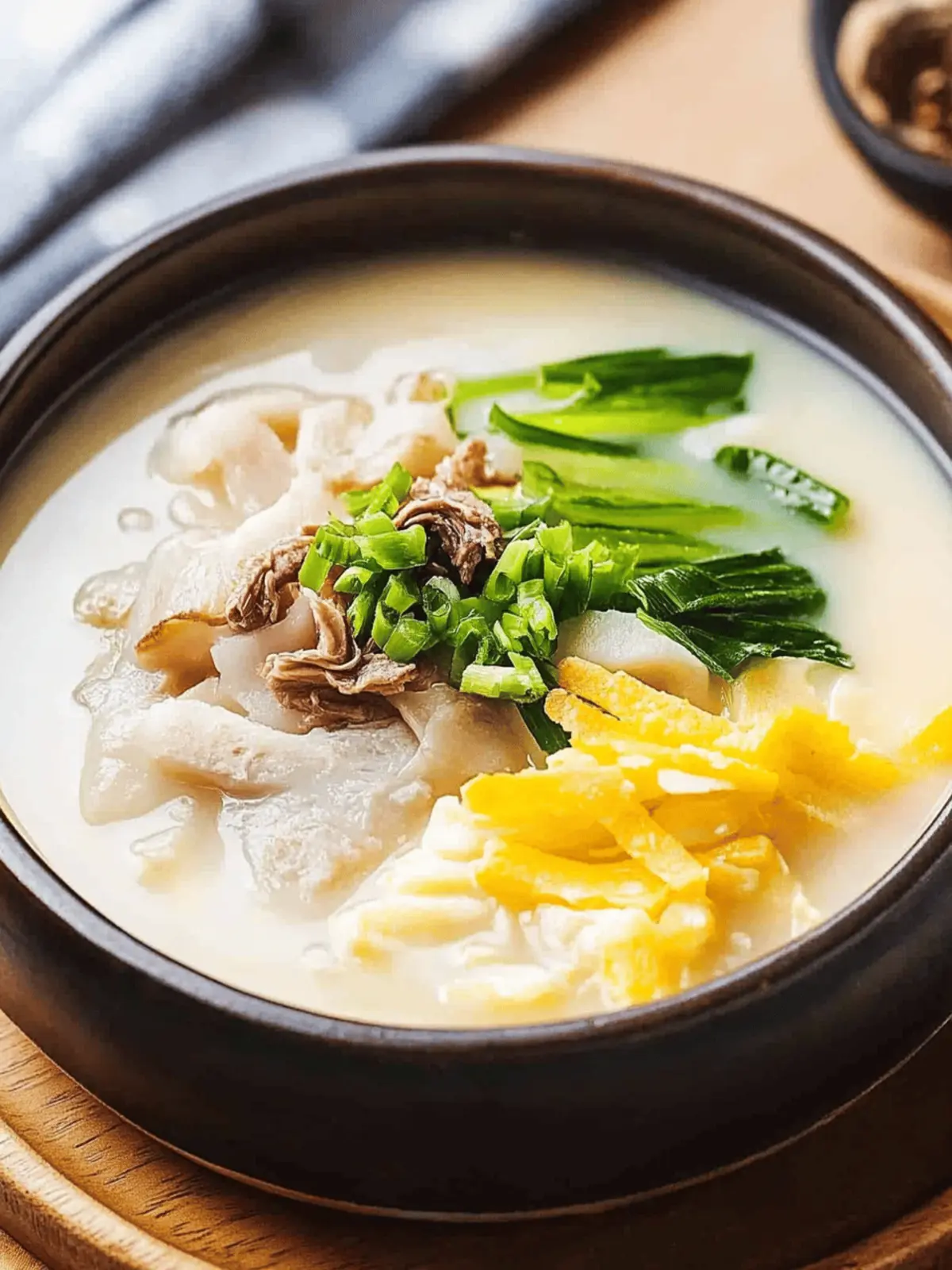
Warm Up with Authentic Korean Rice Cake Soup Delight
Ingredients
Equipment
Method
- Soak the Tteok in cold water for a couple of minutes until they fall apart. Drain once separated.
- Peel the onion and leave it whole. Wash the green onions. Soak beef in cold water for 30 minutes.
- Combine water, beef, and onion in a pot. Bring to a boil over medium-high heat, uncovered. Lower the heat, cover, and simmer for 1 hour.
- Test the doneness of the beef with a fork. If tender, remove the brisket, let cool, and cut into pieces.
- Season torn beef pieces with the remaining soy sauces, garlic, green onion, and garnish ingredients. Massage well.
- Whisk the two eggs with a pinch of salt and set aside.
- Discard the onion from the broth. Season the broth by adding Guk Ganjang and sea salt.
- Add tteok to the broth and cover. Bring back to boil, then add dumplings and simmer for about 5 minutes.
- When rice cakes and dumplings float, swirl in the egg mixture. Add green onions and turn off heat.
- Ladle soup into bowls and top with seasoned beef, green onions, sea laver, and a dash of black pepper.

